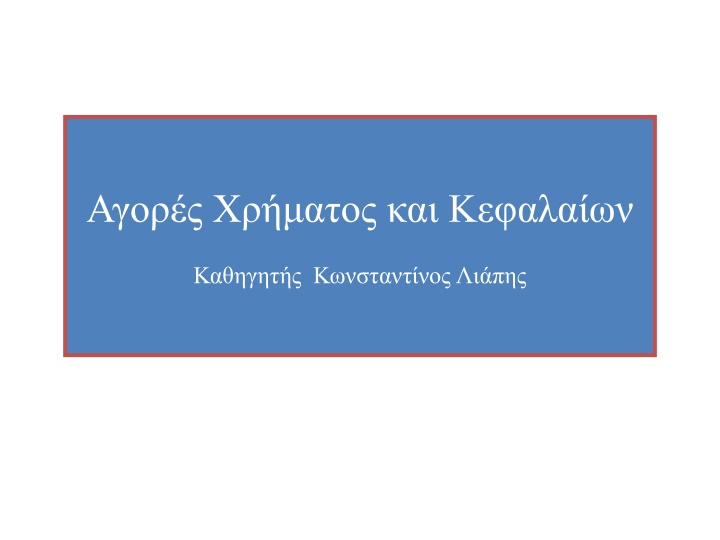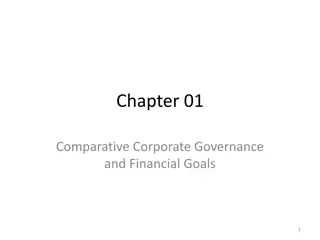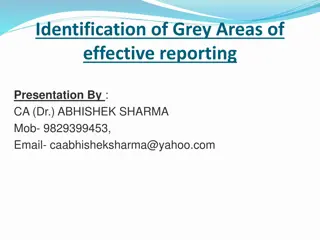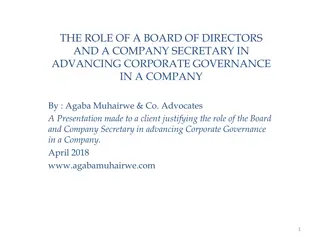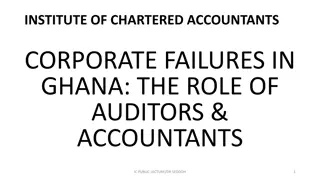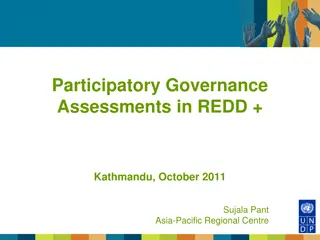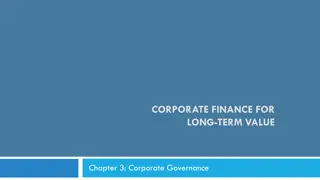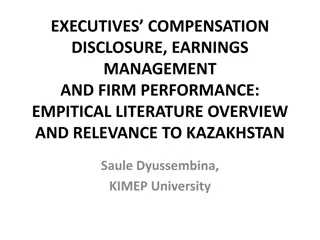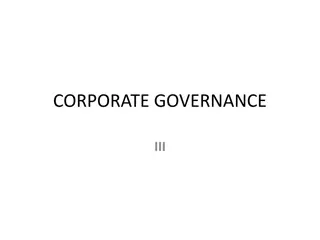Financial Management and Corporate Governance Overview
Explore topics like financial options valuation, capital structure, dividend policy, merger activities, risk management, and more in financial management. Understand the key mechanisms of corporate governance and agency relationships in the business environment.
Download Presentation

Please find below an Image/Link to download the presentation.
The content on the website is provided AS IS for your information and personal use only. It may not be sold, licensed, or shared on other websites without obtaining consent from the author.If you encounter any issues during the download, it is possible that the publisher has removed the file from their server.
You are allowed to download the files provided on this website for personal or commercial use, subject to the condition that they are used lawfully. All files are the property of their respective owners.
The content on the website is provided AS IS for your information and personal use only. It may not be sold, licensed, or shared on other websites without obtaining consent from the author.
E N D
Presentation Transcript
Financial Management and the Financial Environment, Corporate Governance Time value of money Financial Options and their Valuation Real Options Capital Structure Dividend Policy Lease Financing Hybrid Financing: Preferred Stock, Warrants, and Convertibles Initial Public Offerings, Investment Banking and Financial Restructuring Bankruptcy, Reorganization and Liquidation Mergers , LBOs, Divestitures, and Holding Companies Derivatives and Risk Management Financial Management in Non-for Profit Businesses 2
CHAPTER 1 , An Overview of Financial Management : Preferred Stock, Warrants, and Convertibles , , , (LBOs) ,
: Capital budgeting What long-term investments or projects should the business take on? Capital structure How should we pay for our assets? Should we use debt or equity? Working capital management How do we manage the day-to-day finances of the firm?
: (Maximize profit) (Minimize costs) (Maximize market share) (Maximize the current value of the company s stock) :
(agency relationship An agency relationship arises whenever one or more individuals, called principals, (1) hires another individual or organization, called an agent, to perform some service and (2) then delegates decision-making authority to that agent. Conflicts between stockholders and managers. Conflicts between stockholders and creditors.
Two Primary Mechanisms of Corporate Governance Stick Provisions in the charter that affect takeovers. Composition of the board of directors. Carrot: Compensation plans.
If you were a bank lending officer looking at the situation, what actions might make a loan feasible? Creditors can protect themselves by (1) having the loan secured and (2) placing restrictive covenants in debt agreements. They can also charge a higher than normal interest rate to compensate for risk.
What are the potential consequences of inflating earnings or hiding debt? If the firm is publicly traded, the stock price will probably drop once it is revealed that fraud has taken place. If private, banks may be unwilling to lend to it, and investors may be unwilling to invest more money.
What kind of compensation program might you use to minimize agency problems? Reasonable annual salary to meet living expenses Cash (or stock) bonus Options to buy stock or actual shares of stock to reward long-term performance Tie bonus/options to EVA
Financial Markets Physical Asset Markets vs Financial Asset Markets Spot Markets vs Futures Markets Money Markets vs Capital Markets Primary Markets vs Secondary Markets
(Financial Markets) (Investors) (Stocks and Bonds) (Firms) (securities) Bob (Money) Sue (money) (Primary Market) (Secondary Market)
There are many different types of financial markets. Each market serves a different region or deals with a different type of security. Physical asset markets, also called tangible or real asset markets, are those for such products as wheat, autos, and real estate. Financial asset markets are for primitive securities and derivative securities. Spot markets and futures markets are terms that refer to whether the assets are bought or sold for on-the-spot delivery or for delivery at some future date. Money markets are the markets for debt securities with maturities of less than 1 year. Capital markets are the markets for long-term debt and corporate stocks. Primary markets are the markets in which corporations raise new capital. Secondary markets are markets in which existing, already outstanding securities are traded among investors. Orders from buyers and sellers can be matched in one of three ways: (1) in an open outcry auction, (2) through dealers, and (3) automatically through an electronic communications network (ECN).
(Financial Institutions) (Investment banks) (Financial Intermediaries) (Commercial banks) (Insurance companies) (Mutual funds)
Transfers of capital between borrowers and savers take place (1) by direct transfers of money and securities; (2) by transfers through investment banking houses, which act as middlemen; and (3) by transfers through financial intermediaries, which create new securities. Capital is allocated through the price system a price must be paid to rent money. Lenders charge interest on funds they lend, while equity investors receive dividends and capital gains in return for letting firms use their money. Four fundamental factors affect the cost of money: (1) production opportunities, (2) time preferences for consumption, (3) risk, and (4) inflation. There are many different types of financial securities. Primitive securities represent claims on cash flows, such as stocks and bonds. Derivatives are claims on other traded securities, such as options. Major financial institutions include commercial banks, savings and loan associations, mutual savings banks, credit unions, pension funds, life insurance companies, and mutual funds.
(Determinants of Market Interest Rates ) r = r* + IP + DRP + LP + MRP r = Risk free rate+ DRP + LP + MRP r = (nominal or quoted rate of interest) r* = (real risk free rate of interest) IP = (Inflation premium) DRP = (Default risk premium) LP = (Liquidity premium) MRP = (Maturity risk premium)
(Term Structure of Interest Rates) Term structure is the relationship between time to maturity and yields, all else equal. It is important to recognize that we pull out the effect of default risk, different coupons, etc. Yield curve graphical representation of the term structure Normal upward-sloping, long-term yields are higher than short-term yields Inverted downward-sloping, long-term yields are lower than short-term yields
- -
(International Risk Factors) (Country risk) (Exchange rate risk) (Economic Factors) (Budget deficit or surpluses) (International trade deficits or surpluses) (Business activity)
Firms increase cash flows by creating value for customers, suppliers, and employees. Free cash flows (FCFs) are the cash flows available for distribution to all of a firm s investors (shareholders and creditors) after the firm has paid all expenses (including taxes) and made the required investments in operations to support growth.
The weighted average cost of capital (WACC) is the average return required by all of the firm s investors. It is determined by the firm s capital structure (the firm s relative amounts of debt and equity), interest rates, the firm s risk, and the market s attitude toward risk. : WACC (weighted average cost of capital) : : : : : D S
The value of a firm depends on the size of the firm s free cash flows, the timing of those flows, and their risk. A firm s fundamental, or intrinsic, value is defined by:
PV; I; INT; FVN; PVAN; FVAN; PMT; M; INOM Opportunity cost rate Annuity; lump sum payment; cash flow; uneven cash flow stream Ordinary (deferred) annuity; annuity due Perpetuity; consol Outflow; inflow; time line; terminal value Compounding; discounting Annual, semiannual, quarterly, monthly, and daily compounding Effective annual rate (EAR); nominal (quoted) interest rate; APR; periodic rate Amortization schedule; principal versus interest component of a payment; amortized loan A perpetuity is an annuity with an infinite number of payments
The four basic statements contained in the annual report are the balance sheet, the income statement, the statement of retained earnings, and the statement of cash flows. Investors use the information provided in these statements to form expectations about the future levels of earnings and dividends, and about a firm s riskiness. The balance sheet shows assets on the left-hand side and liabilities and equity, or claims against assets, on the right-hand side. (Sometimes assets are shown at the top and claims at the bottom of the balance sheet.) The balance sheet may be thought of as a snapshot of the firm s financial position at a particular point in time. The income statement reports the results of operations over a period of time, and it shows earnings per share as its bottom line. The statement of retained earnings shows the change in retained earnings between balance sheet dates. Retained earnings represent a claim against assets, not assets per se. The statement of cash flows reports the effect of operating, investing, and financing activities on cash flows over an accounting period.
Net cash flow differs from accounting profit because some of the revenues and expenses reflected in accounting profits may not have been received or paid out in cash during the year. Depreciation is typically the largest noncash item, so net cash flow is often expressed as net income plus depreciation. Investors are at least as interested in a firm s projected net cash flow as in reported earnings because it is cash, not paper profit, that is paid out as dividends and plowed back into the business to produce growth. Net cash flow = Net income - Noncash revenues + Noncash charges Net cash flow = Net income - Depreciation and amortization Operating current assets are the current assets that are used to support operations, such as cash, inventory, and accounts receivable. They do not include Operating current liabilities are the current liabilities that occur as a natural consequence of operations, such as accounts payable and accruals. They do not include notes payable or any other short-term debts that charge interest. Net operating working capital is the difference between operating current assets and operating current liabilities. Thus, it is the working capital acquired with investor-supplied funds. Net operating working capital = Operating current assets - Operating current liabilities 1) 2) 3)
Operating long-term assets are the long-term assets used to support operations, such as net plant and equipment. They do not include any long-term investments that pay interest or dividends. Total net operating capital (which means the same as operating capital and net operating assets) is the sum of net operating working capital and operating long-term assets. It is the total amount of capital needed to run the business. 4) Total net operating capital = Net operating working capital + Operating long- term assets NOPAT is net operating profit after taxes. It is the after-tax profit a company would have if it had no debt and no investments in nonoperating assets. Because it excludes the effects of financial decisions, it is a better measure of operating performance than is net income. 5) NOPAT = EBIT*(1 - Tax rate)
Free cash flow (FCF) is the amount of cash flow remaining after a company makes the asset investments necessary to support operations. In other words, FCF is the amount of cash flow available for distribution to investors, so the value of a company is directly related to its ability to generate free cash flow. It is defined as NOPAT minus the net investment in operating capital. 5) FCF = NOPAT - Net investment in operating capital 6) Gross investment in operating capital = Net investment in operating capital + Depreciation 7) Operating cash flow = NOPAT + Depreciation. 8) FCF = Operating cash flow - Gross investment in operating capital 9) ROIC = NOPAT / Operating capital
There are five good uses for FCF: Pay interest to debtholders, keeping in mind that the net cost to the company is the after-tax interest expense. Repay debtholders, that is, pay off some of the debt. Pay dividends to shareholders. Repurchase stock from shareholders. Buy short-term investments or other nonoperating assets.
Market Value Added (MVA) represents the difference between the total market value of a firm and the total amount of investor-supplied capital. If the market values of debt and preferred stock equal their values as reported on the financial statements, then MVA is the difference between the market value of a firm s stock and the amount of equity its shareholders have supplied. 10) MVA = Market value of stock - Equity capital supplied by shareholders = (Shares outstanding)*(Stock price) - Total common equity 11) MVA =Total market value - Total investor supplied capital = (Market value of stock + Market value of debt) - Total investor supplied capital
Economic Value Added (EVA) is the difference between after-tax operating profit and the total dollar cost of capital, including the cost of equity capital. EVA is an estimate of the value created by management during the year, and it differs substantially from accounting profit because no charge for the use of equity capital is reflected in accounting profit. 11) EVA = Net operating profit after taxes (NOPAT) - After-tax cost of capital used to support operations =EBIT*(1 - Tax rate) - Total net operating capital*WACC = (Operating capital)*(ROIC WACC)
MVA Calculation Price per share Number of shares (millions) Market value of equity = Share price*(Number of shares) Book value of equity MVA = Market value -Book value EVA Calculation EBIT Tax rate NOPAT = EBIT(1 - T) Total investor-supplied operating capital Weighted average cost of capital, WACC (%) Cost of capital = (Operating capital)*(WACC) EVA = NOPAT - Cost of capital ROIC = NOPAT/Operating capital ROIC - Cost of capital = ROIC - WACC EVA = (Operating capital)(ROIC WACC)
The value of any asset depends on the stream of after-tax cash flows it produces. Tax rates and other aspects of our tax system are changed by Congress every year or so. Interest income received by a corporation is taxed as ordinary income; however, 70% of the dividends received by one corporation from another are excluded from taxable income. Because interest paid by a corporation is a deductible expense while dividends are not, our tax system favors debt over equity financing. Ordinary corporate operating losses can be carried back to each of the preceding 2 years and forward for the next 20 years and used to offset taxable income in those years. In the United States, tax rates are progressive the higher one s income, the larger the percentage paid in taxes. Assets such as stocks, bonds, and real estate are defined as capital assets. If a capital asset is sold for more than its cost, the profit is called a capital gain. If the asset is sold for a loss, it is called a capital loss. Assets held for more than a year provide long-term gains or losses. Dividends are taxed as though they were capital gains.
After-tax income = Before-tax income Taxes = Before-tax income - (Before-tax income) (Effective tax rate) = Before-tax income (1 - Effective tax rate) Pre-tax income needed to pay $1 of dividends = 1 /(1-Tax rate)
Financial statement analysis generally begins with a set of financial ratios designed to reveal a company s strengths and weaknesses as compared with other companies in the same industry, and to show whether its financial position has been improving or deteriorating over time.
Liquidity ratios show the relationship of a firm s current assets to its current liabilities, and thus its ability to meet maturing debts. Two commonly used liquidity ratios are the current ratio and the quick, or acid test, ratio. Asset management ratios measure how effectively a firm is managing its assets. These ratios include inventory turnover, days sales outstanding, fixed assets turnover, and total assets turnover. Debt management ratios reveal (1) the extent to which the firm is financed with debt and (2) its likelihood of defaulting on its debt obligations. They include the debt ratio, times- interest-earned ratio, and EBITDA coverage ratio.
Profitability ratios show the combined effects of liquidity, asset management, and debt management policies on operating results. They include the profit margin on sales, the basic earning power ratio, the return on total assets, and the return on common equity. Market value ratios relate the firm s stock price to its earnings, cash flow, and book value per share, thus giving management an indication of what investors think of the company s past performance and future prospects. These include the price/earnings ratio, price/cash flow ratio, and the market/book ratio.
Trend analysis, where one plots a ratio over time, is important, because it reveals whether the firm s condition has been improving or deteriorating over time. The Du Pont system is designed to show how the profit margin on sales, the assets turnover ratio, and the use of debt interact to determine the rate of return on equity. The firm s management can use the Du Pont system to analyze ways of improving performance. Benchmarking is the process of comparing a particular company with a group of similar, successful companies. Ratio analysis has limitations, but used with care and judgment, it can be very helpful.
Liquidity Asset management Inventory turnover = Sales / Inventories Days sales outstanding = Receivables/(Annual sales/365) Fixed assets turnover = Sales Net / fixed assets Total assets turnover = Sales / Total Assets Debt Management Total debt to total assets = Total liabilities / Total Assets Times-interest-earned (TIE) = Earnings before interest and taxes (EBIT) / Interest charges EBITDA coverage =( EBITDA + Lease payments Interest) / (Principal payments + Lease payments) Profitability Profit margin on sales = Net income available to common stockholders / Sales Basic earning power (BEP) = Earnings before interest and taxes (EBIT) / Sales Return on total assets (ROA) = Net income available to common stockholders / Total assets Return on common equity (ROE) = Net income available to common stockholders / Common equity Market Value Price/earnings = Price per share / Earnings per share Price/cash flow = Price per share / Cash flow per share Market/book (M/B) = Market price per share / Book value per share Current = Current assets/Current liabilities Quick = Current assets Inventories / Current liabilities
A bond is a long-term promissory note issued by a business or governmental unit. The issuer receives money in exchange for promising to make interest payments and to repay the principal on a specified future date. Some recent innovations in long-term financing include zero coupon bonds, which pay no annual interest, but are issued at a discount; floating-rate debt, whose interest payments fluctuate with changes in the general level of interest rates; and junk bonds, which are high- risk, high-yield instruments issued by firms that use a great deal of financial leverage.
A call provision gives the issuing corporation the right to redeem the bonds prior to maturity under specified terms, usually at a price greater than the maturity value (the difference is a call premium). A firm will typically call a bond if interest rates fall substantially below the coupon rate. A redeemable bond gives the investor the right to sell the bond back to the issuing company at a previously specified price. This is a useful feature (for investors) if interest rates rise or if the company engages in unanticipated risky activities. A sinking fund is a provision that requires the corporation to retire a portion of the bond issue each year. The purpose of the sinking fund is to provide for the orderly retirement of the issue. A sinking fund typically requires no call premium
There are many different types of bonds with different sets of features. These include convertible bonds, bonds with warrants, income bonds, purchasing power (indexed) bonds, mortgage bonds, debentures, subordinated debentures, junk bonds, development bonds, and insured municipal bonds. The return required on each type of bond is determined by the bond s riskiness.
The value of a bond is found as the present value of an annuity (the interest payments) plus the present value of a lump sum (the principal). The bond is evaluated at the appropriate periodic interest rate over the number of periods for which interest payments are made. The equation used to find the value of an annual coupon bond is An adjustment to the formula must be made if the bond pays interest semiannually: divide INT and rd by 2, and multiply N by 2.
The return earned on a bond held to maturity is defined as the bond s yield to maturity (YTM). If the bond can be redeemed before maturity, it is callable, and the return investors receive if it is called is defined as the yield to call (YTC). The YTC is found as the present value of the interest payments received while the bond is outstanding plus the present value of the call price (the par value plus a call premium). The nominal (or quoted) interest rate on a debt security, rd, is composed of the real risk-free rate, r*, plus premiums that reflect inflation (IP), default risk (DRP), liquidity (LP), and maturity risk (MRP):
The longer the maturity of a bond, the more its price will change in response to a given change in interest rates; this is called interest rate risk. However, bonds with short maturities expose investors to high reinvestment rate risk, which is the risk that income from a bond portfolio will decline because cash flows received from bonds will be rolled over at lower interest rates. Corporate and municipal bonds have default risk. If an issuer defaults, investors receive less than the promised return on the bond. Therefore, investors should evaluate a bond s default risk before making a purchase. Bonds are assigned ratings that reflect the probability of their going into default. The highest rating is AAA, and they go down to D. The higher a bond s rating, the lower its risk and therefore its interest rate.
